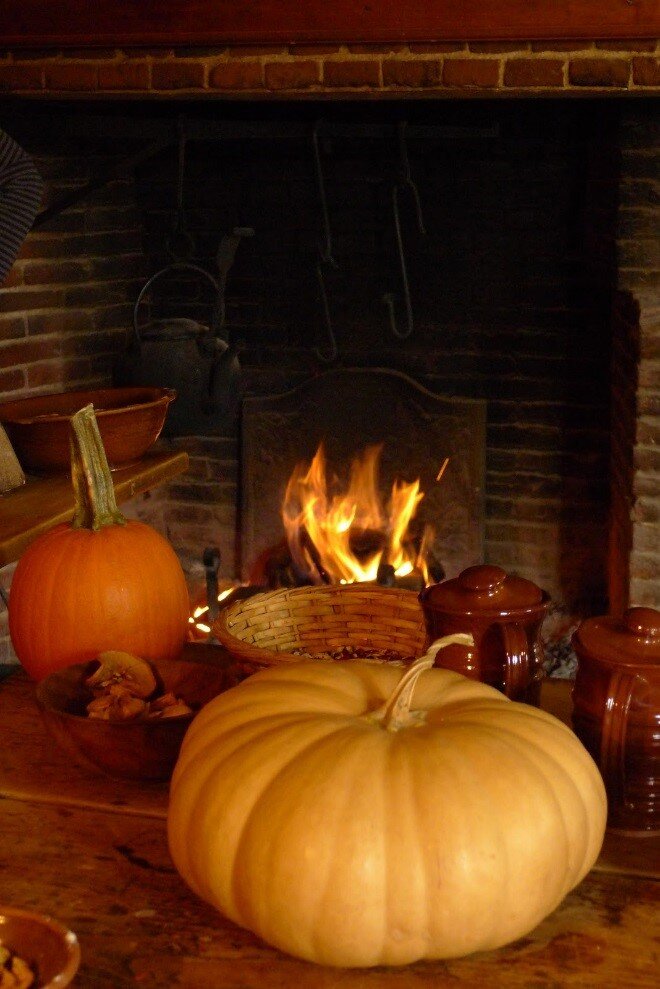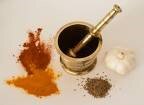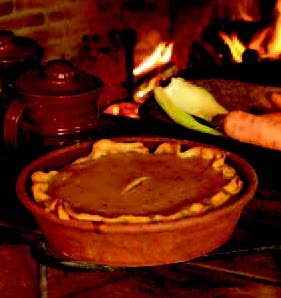Created by Historic Deerfield Education staff members Faith Deering and Claire Carlson
(Originally posted on September 28, 2020)
This is not a blog about pumpkin spice. To be clear, pumpkin spice refers to the spices used to flavor pumpkin pie — cinnamon, nutmeg, ginger and allspice. These warm spices make any pumpkin dish taste better. While today we decorate our yards and front steps with pumpkins and gourds and drink coffee flavored with pumpkin pie spices, long ago the pumpkin and its relatives — winter squashes — were a staple and necessary food item that were stored and eaten over the long and cold New England winters. Today we are encouraging you to learn a little bit more about the wonderful pumpkin and to make and try a few dishes with historic roots.
Pumpkins are native to the Western Hemisphere, and were here in New England when the English settlers arrived in the early 1600s. They are a member of the squash family. Corn, beans, and squash (pumpkin) are known as “The Three Sisters” to New England’s Native peoples. The word “squash” comes from the Narragansett Indian word “askútasquash.” The word “pumpkin” comes from a word with European roots for a “large ripe melon or gourd” —“pumpion” or “pompion” to the English and “pompon” to the French in the 1600s.
Pumpkins and winter squashes have a hard rind or shell that helps the fruit to “keep” longer. Both Native peoples and English settlers found ways to store and preserve foods for use all winter long. One common way of preserving the pumpkin flesh was to cut it into small slices and dry it. When a cook needed some for a “receipt,” all she had to do was to soak it in hot water.
In 1672, an Englishman named John Josselyn wrote a book called New England Rarities Discovered. In it, he describes “The Ancient New England Standing Dish” of “Stewed Pompion.” In Colonial America, a “standing” dish meant that it was served every day, sometimes twice a day! An “ancient” dish meant that early New England cooks relied on this dish to feed their families for months at a time. Imagine eating stewed pumpkin every day, all fall and all winter!
An English cookbook published in 1655 has a receipt called “To Make Pumpion Pye.” The first American cookbook was not published until the late 1700s, and it, too, has a receipt for pumpkin pie. The 1655 receipt uses dried herbs (thyme, rosemary, parsley, and marjoram) and spices (cinnamon, nutmeg, and black pepper). The later receipt calls for cinnamon, ginger, and grated lemon rind.
Today’s cooks have many choices and can buy spices from around the world at their local supermarket. You can buy a spice blend called “pumpkin pie spice” at the store that is a mixture of allspice, cinnamon, nutmeg, and ginger. Each of the spices adds a little special flavor to the mild, sweet pumpkin filling.

IN COLONIAL TIMES, ALLSPICE, CINNAMON, NUTMEG, AND GINGER ARRIVED IN THE COLONIAL COOK’S KITCHEN THROUGH WORLD TRADE. HERE IS WHERE EACH OF THE SPICES IN “PUMPKIN PIE SPICE” IS ORIGINALLY FROM:
-
Allspice – Jamaica Allspice is the dried, unripe fruits of a small, tropical, evergreen tree, Pimenta officinalis, of the myrtle family (Myrtaceae). This species is a native of the West Indies and parts of Central and South America. Allspice is so named because its flavor resembles that of a combination of cloves, cinnamon, and nutmeg.
-
Nutmeg — the Molucca (Spice) Islands Nutmeg is a delicately flavored spice obtained from the nutmeg tree ( Myristica fragrans), a native of the Moluccas, or Spice Islands. The tree is a dark-leafed evergreen, and is a member of the nutmeg family (Myristicaceae).
-
Ginger — China and India Ginger is a plant from tropical and subtropical regions that is grown for its gnarled and bumpy root.
-
Cinnamon — Sri Lanka (Ceylon) and China (cassia or Chinese cinnamon). Cinnamon is the dried aromatic inner bark of certain tropical Asian trees in the genus Cinnamomum, especially C. verum and C. loureirii, that is ground and used as a spice.

TWO OLD RECIPES FOR PUMPKIN DISHES
Pumpkin or Squash Pie
Small pumpkin or squash
2 eggs
2 cups milk
½ cup molasses
dash of salt
2 tablespoons cinnamon
1 tablespoon ginger
peel of ½ lemon, grated
½ recipe for Pie Crust
Cut up the pumpkin or squash; remove seeds, and pare the outside rind. Simmer in a covered saucepan in a small amount of water until tender. Drain water and discard.
While pumpkin cooks, prepare Pie Crust.
Force pumpkin through a sieve or use a food mill. Measure 2 cups puree for each pie. Remainder may be frozen or dried for future use.
Beat eggs and add milk. When blended, add pumpkin, molasses, salt, cinnamon, ginger, and lemon, and stir well.
Line a 9-inch pie plate with piecrust. Pour the pie filling into the pie plate. Bake in 400 degree oven for 15 minutes, then turn down to 375 degrees for 30 minutes or until set.
For common family pumpkin pies, three eggs do very well to a quart of milk. Stew your pumpkin, and strain it through a sieve. Take out the seeds and pare the pumpkin before you stew it; but do not scrape the inside; the part nearest the seeds is the sweetest part. Stir in the stewed pumpkin, till it is as thick as you can stir it round rapidly and easily. Sweeten it to your taste, with molasses or sugar; Two tea-spoonfuls of salt; two great spoonfuls of sifted cinnamon; one great spoonfuls of ginger. The outside of a lemon is very nice. This should bake from forty to fifty minutes
(from Lydia Maria Child, The American Frugal Housewife, 1832)

STEWED POMPION
4 cups cooked and mashed pumpkin or squash (peeled and seeded, and steamed or baked)*
3 tablespoons of butter
2 to 3 teaspoons of cider vinegar
1 or 2 teaspoons dried ginger
½ teaspoon salt
In a saucepan over medium heat, stir and heat all the ingredients together. Adjust the seasonings to taste and serve hot.
* You may substitute 2 15 oz. cans of cooked pumpkin.
The Ancient New England standing dish.
But the Housewives manner is to slice them when ripe, and cut them into dice, and so fill a pot with them of two or three Gallons, and stew them upon a gentle fire a whole day, and as they sink, they fill again with fresh Pompions, not putting any liquor to them; and when it is stew’d enough, it will look like bak’d Apples; this they Dish, putting Butter to it, and a little Vinegar, (with some Spice, as Ginger, &c.) which makes it tart like an Apple, and so serve it up to be eaten with Fish or Flesh.
(from John Josselyn, New England Rarities Discovered, 1672)
Please share a photo of your pumpkin dish and tell us how you made it. Email it to us at historicdeerfield@historicdeerfield.org